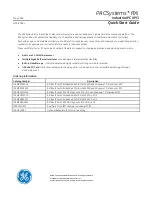
CommandPro
®
General Purpose & Safety Applications
User Manual
9
9M02-9028-A031-EN
Rev 4
The 900 MHz band has worked well for most users, and not being burdened with licensing regulations is often
desirable. The FCC has allowed 50,000 microvolts per meter field strength on this band, which is 250 times
higher than other unlicensed frequencies below this band. This allows our systems to operate very reliably in the
presence of other signals.
4.1.4 Command Format
We use packet-mode, Frequency Modulation (FM) to carry commands in a packet form from our transmitter to our
receiver.
To reduce battery drain, our transmitter transmits for a hundredth of a second, which is long enough to send one
packet to our receiver at a repetition rate of either 16 or four times per second.
The rate varies: 16 times per second for three times when sending a command and four times per second when
there is no change in commands and the transmitter is still on. Any time a lever or switch is activated, we send all
control settings three times at the 16-per-second rate and then return to the slower rate of four times per second.
Our receiver uses the slower rate for maintaining transmitter timing and provides for a maintained link where one
is used. The only exception t
o this is the ‘STOP’ switch, which transmits at 16 times per second as long as it is
depressed. In addition to lever and switch positions, each packet contains a unique address and CRC check sum
(described in the next section).
4.1.5 Safety
Safety and preventing loss of control are very important issues at Cattron. We use a unique identification code for
each user. There are provisions in the system for 65,535 individual codes.
Each transmission includes a CRC check sum, which is a polynomial created by factoring all of the previous bits
transmitted. Once the receiver receives a valid start command from the transmitter, the receiver tracks the time of
the transmitter and ignores all other transmissions that do not fall within the expected time frame of the
transmitter.
Maintained link systems must receive at least one valid transmission each second in order to allow the remote-
controlled equipment to function. The receiver provides a loss-of-signal control output that safely shuts down the
equipment if a loss of signal occurs.
The receiver will not allow restart of equipment under its control after a loss of signal until a valid system start
command is received from our transmitter. This prevents an unintended start-up from occurring if the transmitter
returns within range of the receiver and is still operating.
The transmitters also check the position of all controls upon start-up. The transmitter will not issue a start
command if any of the controls are pressed at the time the start command is invoked.
4.1.6 Monthly Inspection Schedule
It is recommended that the following tasks are performed once a month:
•
Inspect the transmitter for damage to keypad and case
•
Inspect all electrical and antenna connections to ensure they are clean and tight
•
Ensure all terminal strips are firmly in place










































